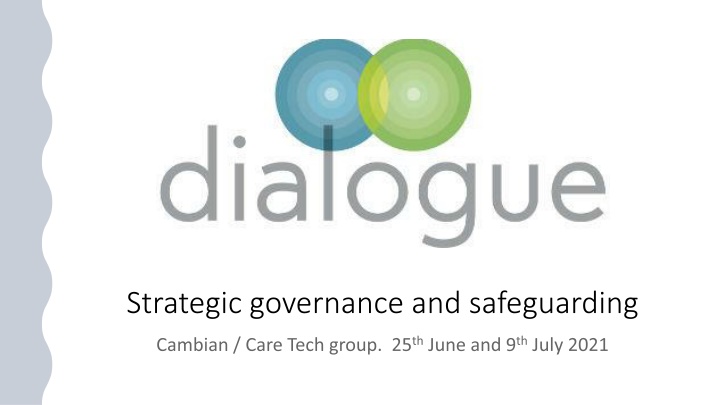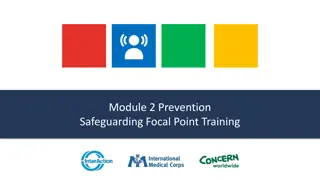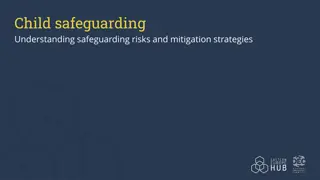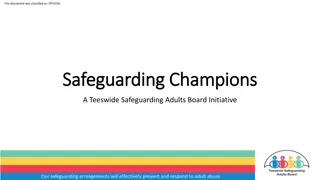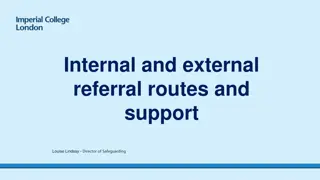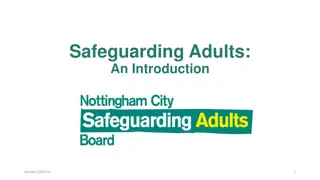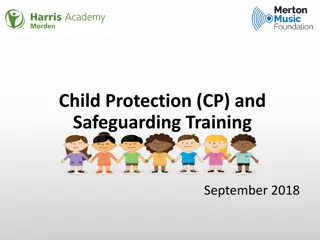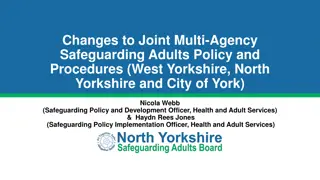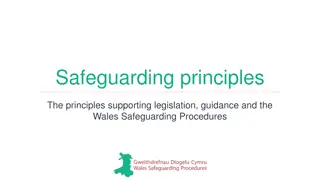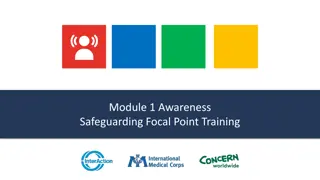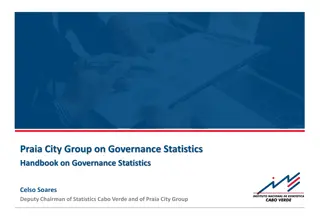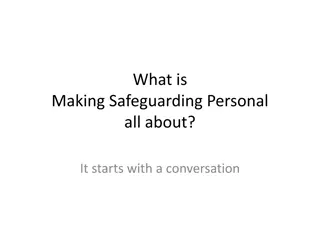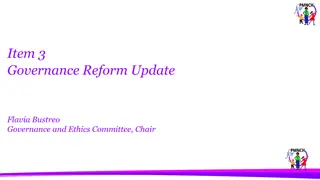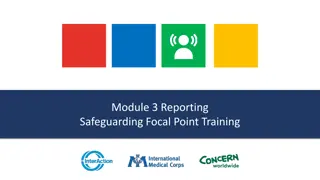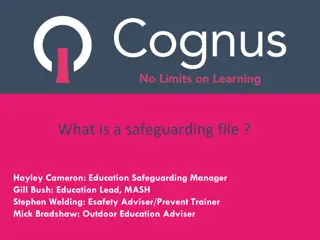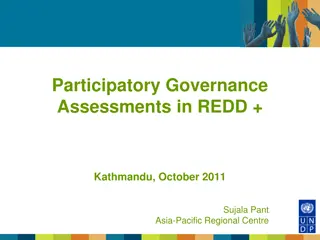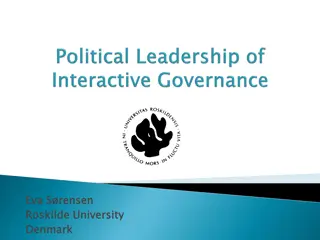Strategic Governance and Safeguarding Sessions
These sessions delve into the strategic role of governance and safeguarding, addressing regulatory frameworks, resourcing, and balancing business needs with safeguarding requirements. Explore key themes, tensions, and the importance of honest, open dialogue for effective safeguarding practices.
Download Presentation

Please find below an Image/Link to download the presentation.
The content on the website is provided AS IS for your information and personal use only. It may not be sold, licensed, or shared on other websites without obtaining consent from the author.If you encounter any issues during the download, it is possible that the publisher has removed the file from their server.
You are allowed to download the files provided on this website for personal or commercial use, subject to the condition that they are used lawfully. All files are the property of their respective owners.
The content on the website is provided AS IS for your information and personal use only. It may not be sold, licensed, or shared on other websites without obtaining consent from the author.
E N D
Presentation Transcript
Welcome to two sessions exploring the strategic role of governance and safeguarding: Day 1 - An exploration of how governance is cohesively led at senior leadership level - We will explore the role and structure of regulated frameworks - The governance requirements within the frameworks - Expectations re. culture - Resourcing safeguarding - Pulling together key strategic themes approach Day 2 - Tensions between business need , targets and safeguarding - Is your data robust, external view? - Does it safely inform strategy? - Reputational loss and potential links to safeguarding
Each delegate needs to be honest as well as open. Value a diversity of opinions on all topics - different people with different views and opinions. These opinions may clash with each other. Suggestions can then be noted, referred to later or taken away for further consideration Opportunity for everyone for equal participation Be open to new approaches as well as listen to new ideas. Group agreement- safeguarding / strategic governance Na ve questions are useful Balanced participation Anything else you wish to add?
Safeguarding-resourcing all aspects:- Take 15 minutes to identify the resources required to ensure effective safeguarding throughout the organisation. One person to feedback from each group Are these in place ? Any pinch points? Areas of tension?
Meeting the requirements of all service regulatory frameworks which apply Meeting the requirements of employment law Meeting the requirements of health and safety law Recruitment processes including : Safeguarding is the responsibility of organisations to make sure their staff, operations, and programmes, do no harm to children and adults at- risk nor expose them to abuse or exploitation- this needs to be resourced in all aspects strategically , operationally. - Advertising - Long listing - Short listing - Interview / appointment - Safer recruitment HR departments and processes
Everyone connected to your organisation, should know how to keep children, adults at-risk, and staff safe Training- across all aspects of the organisation/recording training/external expert input/specialist input - E learning- electronic platforms - Face to face - Updates DBS Electronic recording systems e.g. Cpoms DSL/ DDSL / safeguarding leadership and training / CPD Building in capability and capacity
Safeguarding is the responsibility of organisations to make sure their staff, operations, and programmes do no harm to children and adults at- risk nor expose them to abuse or exploitation- this needs to be resourced in all aspects strategically , operationally. Governance training / support Policy , procedure , process writing / review Resource unexpected costs which may be related to an inspection outcome, change in legislation / guidance etc Unexpected cost pandemic Agency staff / supply staff Equity of resource by area , service, person? Internal / external governance audit / review Anything else?
This has been a lesson hard learned by the charitable / NGO sector when several major disclosures re. staff led to scandal and crisis for organisations such as Oxfam. Serious case reviews and safeguarding reports reflect on under resourcing and funding of safeguarding An Inquiry will look top down / bottom up at this, as a key line of enquiry Unless safeguarding is seen as a core principle and responsibility for ALL then it can be defined as a weakness within the overall organisation. It may not surprise you, to know that safeguarding is often under resourced .
Has a safeguarding resource map such as this been carried out? What could it tell you about the organisation? What actions may need to arise - from your own knowledge? Open discussion
Protecting people and safeguarding responsibilities should be a strategic priority for all organisations. Board members must take reasonable steps to protect all people who come into contact with the organisation from harm, which is a WIDER duty than just taking care of young people and vulnerable adults. All board/governance members should have at least the level of knowledge equivalent to the staff working in the settings What is the organisations strategic role in safeguarding? How does this sit with business tensions
In crude terms all markets operate in a dynamic tension between demand for goods or services and the supply of those goods and services at a given price: - Few markets operate in an unregulated environment. - There is a dynamic relationship between regulation, quality, price and supply. - Although care markets may have tighter regulations and controls, they are still strongly influenced by the interaction between supply and demand HOW CAN THIS IMPACT ON SAFEGUARDING? DO THE TWO NATURALLY ALIGN? CAN THEY? OPEN DISCUSSION ..
Loss of or damage to reputation is the risk of taking risks ..
Getting safeguarding right is absolutely key from top to bottom of an organisation and in many ways can be separated from reputational risk . However, you cannot eradicate risk only mitigate to as low a level as possible and for some services this will still be a high level of risk given the nature of the children , young people and adults who are placed. Occupancy (85% + ) generally equates to financial viability and is seen as an organisation protective factor . Cross organisation risk analysis ( not just for insurance purposes) and includes levels of assumptive risk tied to : Safeguarding , business and reputation- get safeguarding right! - groups/ areas - individual services - market- growth / stability / need etc. - crises current and historic for the organisation and others in the news. - what else?
To label safeguarding as a reputational risk is to misunderstand the issue. The primary impact of safeguarding failures is abuse of children and the long term physical and psychological consequences. Since safeguarding is a primary risk of an organisation, the management and governance response is confused if it also appears as a reputational risk with its implication of a tacit acknowledgment that safeguarding is potentially weak and a risk Safeguarding and reputation ..
Safeguarding , business and reputation- get safeguarding right! WEAK safeguarding is the reputational risk factor (as Castlebeck discovered with Winterbourne View in the case of adult care) and can have a substantial impact on the viability of an organisation, regardless of its profitability. Increasing the spend on a communication team to put out the message can imply the something to hide scenario - even more reason to invest time and money in safeguarding itself. Put simply, reputation can be thought of as deriving from three different things. - Trustworthiness - Competency - Values - ARE THESE THREE FACTORS SECURE?
How do organisations/ services / departments protect their reputation? Proactive approach to adaptation , change embedding change. Building resilience across the whole organisation to prevent occurrence of the consequential risk to reputation. Creating culture of responsibility throughout the organisation (reputation can t be effectively managed in a single layer of a large organisation). Training at all levels, including senior executives. Minding your own business model to make sure you understand how every internal and external element of your provision influences the organisations success. DO YOU RECOGNISE THIS?
Insurance is not the sole answer. Does the organisation s register of risks accurately reflect a safeguarding profile .. Is this informed by robust data strands in relation to safeguarding?
Urban myth vs reality ------- Care Review could be an example? Lens / filter used in commissioning , contracting from LA level to individual placing officer / SW level- all impact. Does this have an impact- - on staff? Recognise the role and impact of: - managers? - recruitment? - long term impact on business? - do you fight it ? Do you fight it? If not , why not?
Current models in large organisations which have been seen to be working Health models of governance and safeguarding NGO codes of conduct and governance- after a very difficult period , a wholesale sector review undertaken External / internal mechanisms to ensure date is robust HOW DO YOU KNOW YOUR SAFEGUARDING DATA IS ROBUST AND EFFECTIVELY INFORMS PLANS , RESOURCE MAPPING , DEVELOPMENTS ETC? OPEN DISCUSSION.
A complex dynamic with the safety of children and young people at its heart Essentially the board and everyone in the organisation will be held accountable for their knowledge, practice ( as appropriate) - - ensuring children and young people in the organisations care receive high quality, evidence based education / care - live and learn safely in appropriate environments - with the right staff, who share the same vision, values and expected behaviours. - do no harm to children and adults at-risk nor expose them to abuse or exploitation ------ robust , effective safeguarding ..
Any thoughts? Ideas going forward? Next steps?
